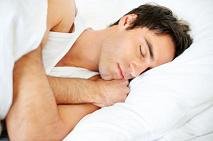Advertisment
Upper-airway stimulation shows efficacy for obstructive sleep apnea

by Bruce Sylvester: Electronic stimulation therapy to the upper airway during sleep is effective in reducing obstructive sleep apnea (OSA), researchers reported in the Jan. 9, 2014 issue of the NEJM / New England Journal of Medicine.
In the STAR (Stimulation Therapy for Apnea Reduction) trial, investigators tested an implantable electronic stimulation device called Inspire™ Upper Airway Stimulation (UAS) therapy, which delivers stimulation to the hypoglossal nerve timed to each breathing cycle. The stimulation restores tone during sleep to the muscles controlling the base of tongue, thereby helping to prevent the tongue from collapsing and obstructing the airway during sleep.
“This device is a first-of-its-kind therapy and has the potential to help the many people suffering from moderate to severe sleep apnea who are unable to use or cannot tolerate CPAP (continuous positive airway pressure),” said investigator Kingman Strohl, MD, professor of medicine at Case Western Reserve University School of Medicine in Cleveland, Ohio. “At a year following surgical implantation, patients experienced substantial decreases in the number of interruptions of sleep by apnea, and improvements in symptoms of waketime sleepiness, snoring and quality of life,” he added
Researchers conducted the phase III study at several American and European sites. They enrolled 126 subjects, and 83 percent were male.
Each eligible subject had been diagnosed with moderate to severe sleep apnea and had been unable to accept or adhere to CPAP therapy. Also they were required to have a BMI under 32, a range of apneas in the moderate to moderately severe range, and evidence that the sleep-related obstruction might involve the tongue.
The investigators used two scales to measure outcomes, the apnea-hypopnea index (AHI; the number of apnea or hypopnea events per hour) and the oxygen desaturation index (ODI; the number of times per hour of sleep that the blood oxygen level drops by more than four percent).
The researchers reported that, at 12 months, median AHI decreased 68 percent and ODI decreased 70 percent.
Most subjects reported reduction of sleep apnea effects and improved quality of life.
After the 12-month assessment, the investigators undertook a sub-study comparing 23 subjects who continued with the therapy to 23 participants who had the therapy withdrawn for a week.
They found that the withdrawal group had a sharp rise in median AHI score, along with snoring and fatigue. This suggested that the stimulation by the device was therapeutic.
“While many patients have found help with CPAP, some patients struggle with CPAP or cannot tolerate the mask, and thus remain untreated,” Dr. Strohl said. “The severity of OSA in this group might not be easily managed by oral appliance or surgery. Upper-airway stimulation could provide an effective alternative,” he added.
Patients control the Inspire therapy at home using a handheld programmer. Unlike other surgical procedures for sleep apnea, Inspire therapy does not require altering a patient’s facial or airway anatomy.
Inspire UAS therapy is under regulatory review by the FDA. There is a provisional approval for the therapy in Europe.





